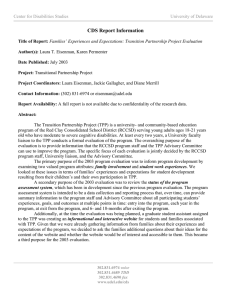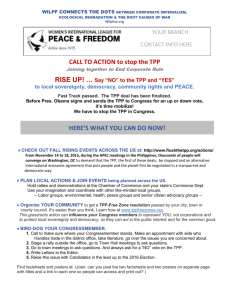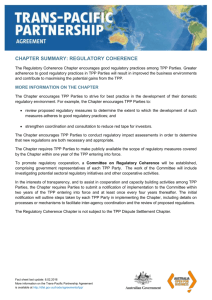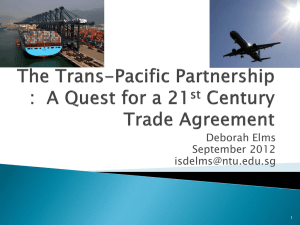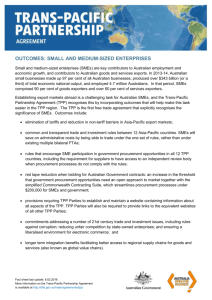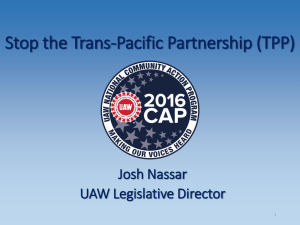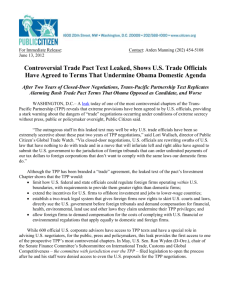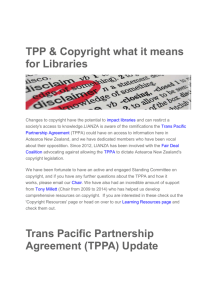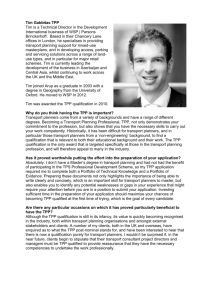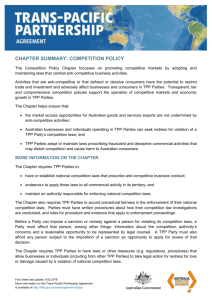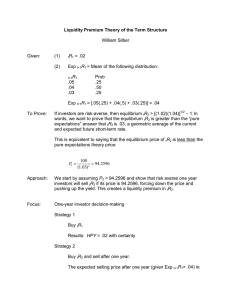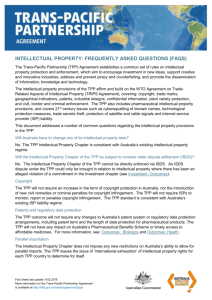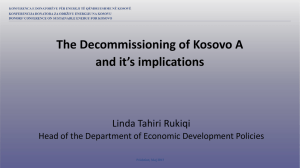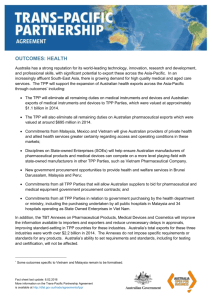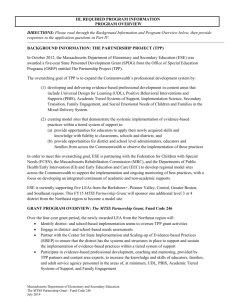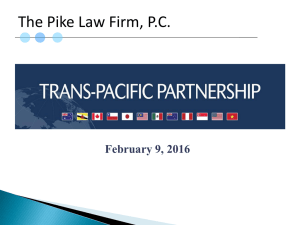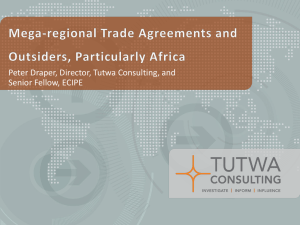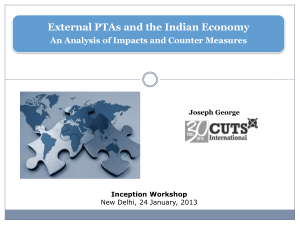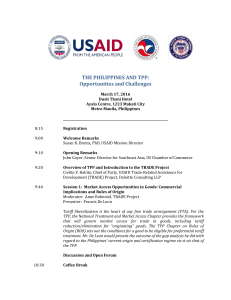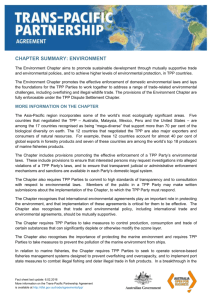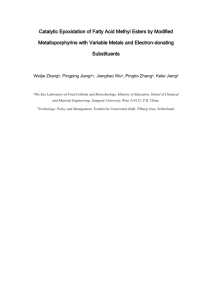President Obama & the Trans-Pacific Partnership. - US-Global
advertisement
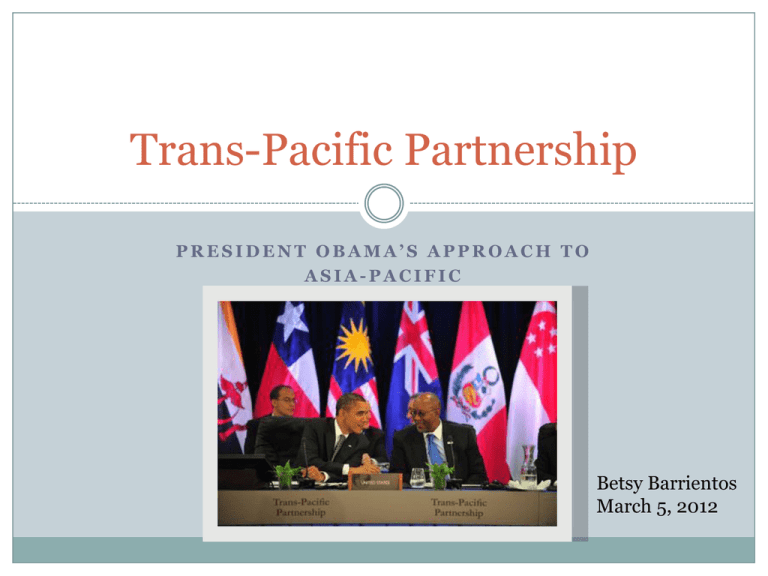
Trans-Pacific Partnership PRESIDENT OBAMA’S APPROACH TO ASIA-PACIFIC Betsy Barrientos March 5, 2012 Agenda 2 TPP Overview TPP Components President Obama’s Approach U.S. National Interests Commonwealth of Virginia Potential Impediments to the Agreement Policy Analysis Q&A Overview 3 TPP Origins Into force in 2006 Trade liberalization in the Asia Pacific Region Original signatories: Brunei, Chile, New Zealand and Singapore Overview 4 Original Brunei, Chile, Singapore, NZ In Negotiation Australia, Malaysia, Peru, Vietnam, USA Potential Members Canada, Japan, Mexico Overview 5 Notably missing: China Overview 6 Geographically diverse Comprehensive trade agreement Elimination of all tariffs among all countries by 2017 (99% with Brunei) Negative list for Services and Investments - unless specifically mentioned, a category is assumed to be covered by the agreement Overview 7 Includes: sanitary and phytosanitary standards technical barriers to trade competition policy IPR government procurement environmental and labor standards President Obama’s Approach 8 “America’s first Pacific President” - November 2009 “... the Asia Pacific region is key to achieving my goal of doubling U.S. exports and creating new jobs." - November 2011 Increase engagement in all aspects of its relations with countries in the region President Obama’s Approach 9 Strategic alliances with Philippines and Australia Clinton’s visit to Myanmar Conditional food aid to North Korea President Obama’s 10-day trip to Asia TPP main trade objective of the Administration TPP Agreement: U.S. Policy Objectives and Interests 10 Expand and increase trade Shape economic interactions in the region Positive engagement and commitment to Asia Catalyst for other Asian Pacific countries to join the TPP agreement Trans-Pacific integration vs. intra-Asian integration Specific Areas of U.S. National Interests 11 Agriculture increase regulatory coherence, eliminate redundancies in testing and certification of food and animal and plant health Manufacturing linkages to supply chains across the region Intellectual Property Rights Follow TRIPS; trademarks, copyrights, patents, trade secrets, etc Green growth and e-commerce illegal subsidies to fisheries, illegal wildlife trade taxing of electronic transactions, authentication of online transactions, consumer protection Concerns for the Commonwealth of Virginia 12 Tobacco leaf and products not included as part of the agreement no protection or incentives for this sector industry might be at a disadvantage as it has limited access to a global market Risks 13 Regional agreement undermines WTO and Doha Round Trade diversion: lower tariffs of an agreement causes trade to be diverted away from a more efficient producer outside the bloc “Spaghetti bowl” effect: overlapping and inconsistent FTAs Impediments 14 Potential Impediments 15 Agriculture New Zealand’s dairy products could have improved access to US market Japan’s politics and government policies relating to agriculture (rice). Potential Impediments - Con’t 16 Intellectual Property Inconsistent policies among countries Copyright and patent terms that adhere to US standards, e.g. endless copyright terms Strong emphasis on pharma and multi-media Elimination of parallel trade on copyrighted materials Potential Impediments - Con’t 17 Access to Medicine Seize shipments of drugs on suspicion on IP infringement and to increase damages from IP infringement Increase of data exclusivity - prevents existing clinical trial data to be shared with makers of generic drugs Increase of duration patent terms - could delay competition of generic brands Access to affordable medicine for developing countries Schemes of subsidized medicine in New Zealand TPP: Policy Analysis 18 FTAs already signed with most TPP countries; trade barriers low Market size of countries small, if considered individually Is the TPP an economic agreement? Yes, for the most part… it has the potential to be much more TPP: Policy Analysis 19 As an economic agreement, TPP could raise standards for market access and bridge differences between American and Asian regions Potential to represent about 40% of total global trade AND Establish a new framework for future FTAs Enable “presence” in the region and thus influence economic and strategic initiatives TPP: Policy Analysis 20 Intellectual Property TRIPS+ may not be suitable for all TPP countries Undermine alternative IP standards Potential to negatively affect health sector in some countries TPP: Policy Analysis 21 As an alternative, US could update IP and copyright laws and engage in patent reforms IP and copyright laws set in the 1970s Guidance and consultation from additional industries, other than pharmaceutical and recorded media. TPP: Policy Analysis 22 Also consider the challenges of the following: President Obama may seek trade promotion authority (TPA) For Asia, TPP is not the only option to increase trade ASEAN +3, bilateral agreements If TPP agreement fails, U.S. could see its position weakened in the region 23 QUESTIONS?
